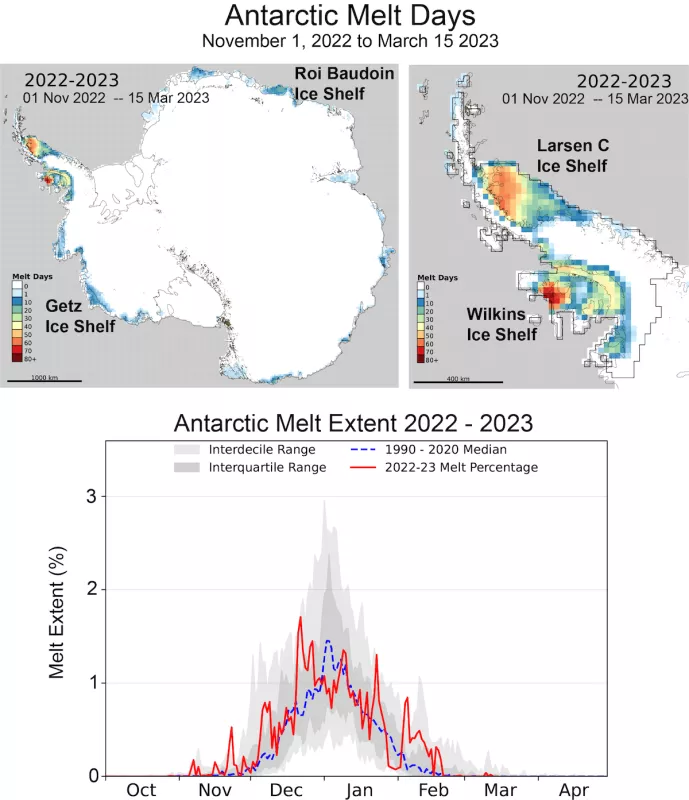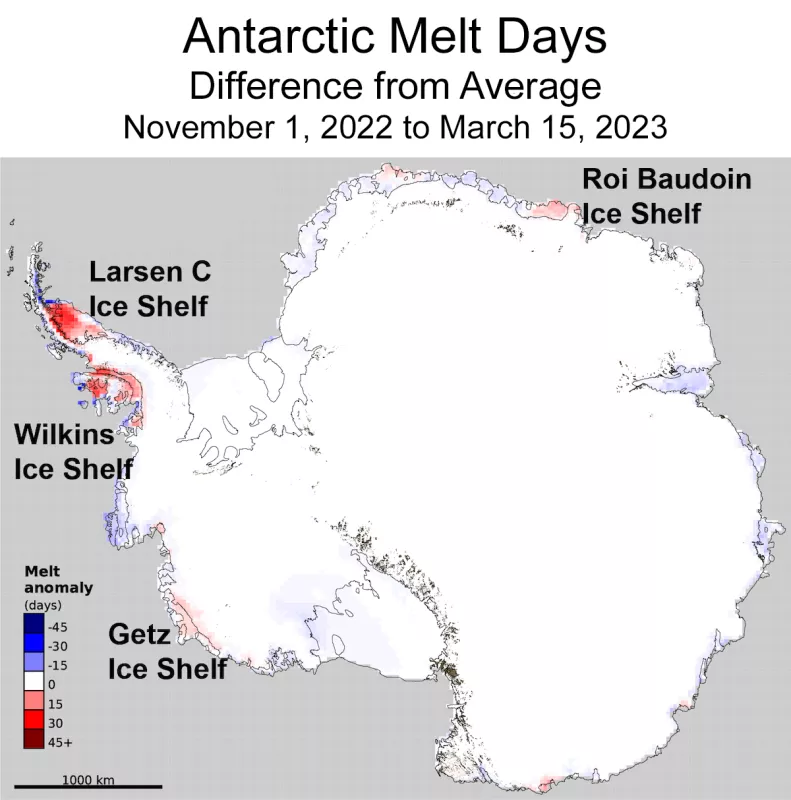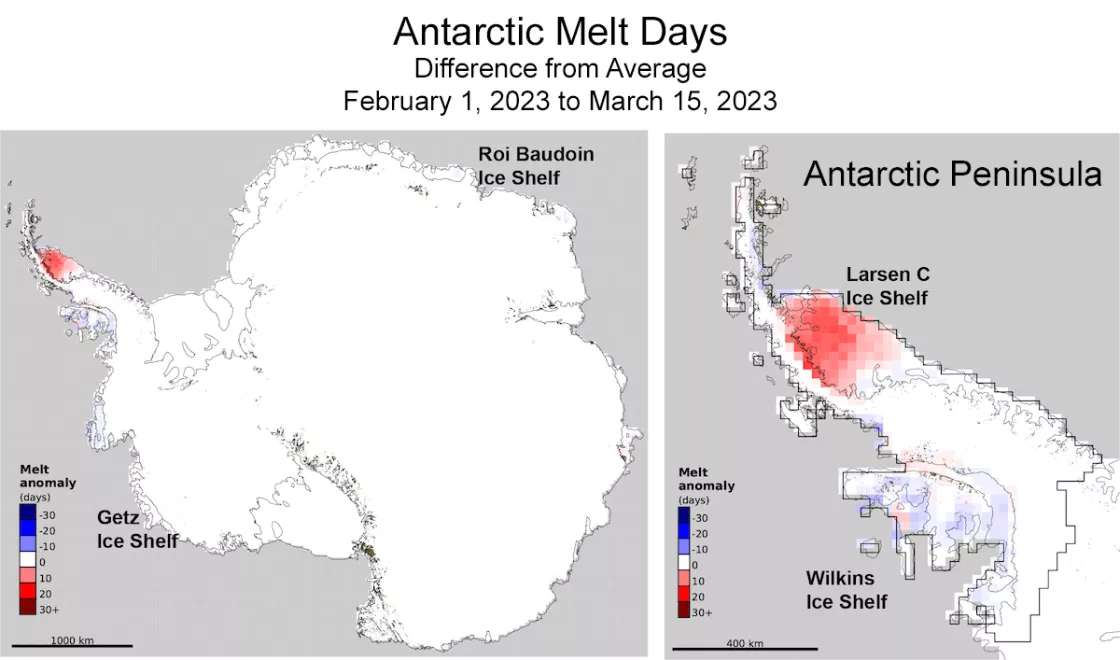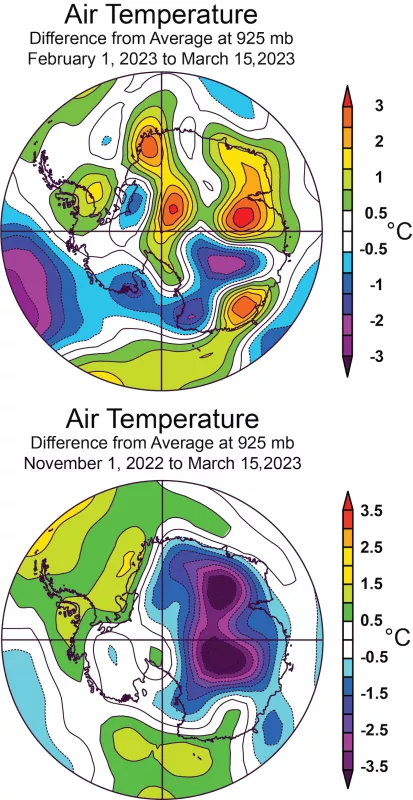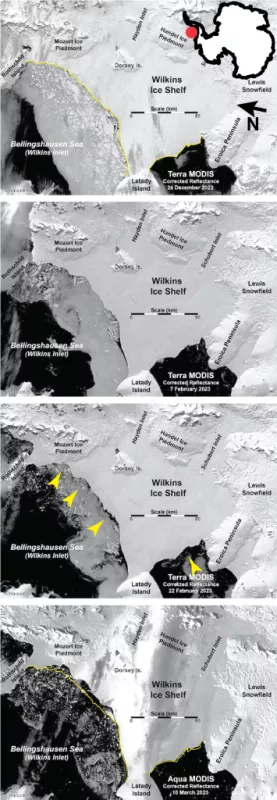The Antarctic Peninsula has had an intense melt season with above average melting persisting through much of February. Saturated snow from a high melt year and low sea ice in Bellingshausen Sea have led to a series of minor calving events on the Wilkins Ice Shelf. Elsewhere in Antarctica, melting was near average.
Current conditions
Melting of the Antarctic Ice Sheet from November to mid-March followed a pattern, where both sides of the Antarctic Peninsula had extensive and frequent melting while elsewhere along the coast patches of melt rarely exceeded 10 days for the season (Figure 1a). However, these small totals represent an above average melt season for the Getz and Roi Baudoin Ice Shelves. In the Peninsula, the northern half of the Larsen C Ice Shelf experienced up to 60 days of melt between November 1 and March 15. During that same time period, some areas of the Larsen C Ice Shelf showed more than 30 days of melt above the average melt days for the 1990 to 2020 reference period (Figure 1b). The Wilkins Ice Shelf, southwest of the Peninsula, had over 70 days of surface melting for the same time period. Overall, Antarctica’s seasonal melt-day total was slightly higher than the 1990 to 2020 average, with significant melt extent events (exceeding the upper decile range) around December 20, January 20, and February 5. Although some groups reported high temperatures and melting over the Ross Ice Shelf in early January, satellite measurements reported no evidence of melting there at that time. In the latter part of the melt season, melting was limited almost entirely to the Peninsula areas. The northern Larsen C continued to see above-average melting, with 10 days more than average in the 45-day window (Figure 1c). However, the frequency of melting slightly for the Wilkins and George VI Ice Shelf areas, and the extensive melt ponding seen in December and January slowly froze over.
Conditions in context
For the February to mid-March period, relatively warm conditions were present in many parts of the ice sheet (Figure 2, top). However, even in mildly warm summers, temperatures still remain below the melting point on most of the continent. The exception is the Peninsula area where average temperatures were near or above the melting point with temperatures up to 1.5 degrees Celsius (3 degrees Fahrenheit) above average, leading to extensive melting in some areas. Above average temperatures for much of the coastline reflected the extremely low sea ice extent as Southern Ocean sea ice reached a new record low. Looking at the season overall, while the Peninsula had 0.5 to 1.5 degrees Celsius (1 to 3 degrees Fahrenheit) above average temperatures between November 1, 2022 to March 15, 2023, most of the Antarctic interior had below average temperatures (Figure 2, bottom). While brief periods of melting occurred along the East Antarctic coast and parts of West Antarctica along the Amundsen Sea, in general melting was infrequent in all regions except the eastern and western sides of the Antarctic Peninsula.
Wilkins Ice Shelf calving events
During the austral summer of 2022-2023, the Wilkins Ice Shelf, located on the southwestern side of the Antarctic Peninsula, lost a significant area of mélange, which is a mix of icebergs and sea ice. The ice edge retreated along both the western ice edge (between Rothschild Island and Latady Island) and the southern ice edge (between Latady Island and Eroica Peninsula). Total area lost was approximately 160 square kilometers (62 square miles), although much of the loss along the western edge was mélange that had formed from past break-up events in 1998, 2008 and 2009, as mapped earlier by our colleagues Mathias Braun and Angelika Humbert. Retreat occurred along four areas of the Wilkins mélange and ice shelf front. In the most northern area of shelf ice loss, retreat proceeded to the Mozart Ice Piedmont coast, and in the other regions along the western edge retreat, calvings removed a maximum of 5 kilometers (3 miles) from the previous mélange or ice shelf edge. The warm conditions of the 2022-2023 summer, with above average melt days, and the extended period of very low sea ice in the Bellingshausen Sea, likely contributed to the series of small ice loss events.
References
Braun, M., A. Humbert, A. and Moll. 2009. Changes of Wilkins Ice Shelf over the past 15 years and inferences on its stability. The Cryosphere, 3(1), 41-56, https://doi.org/10.5194/tc-3-41-2009.
Humbert, A. and M. Braun. 2008. The Wilkins Ice Shelf, Antarctica: break-up along failure zones. Journal of Glaciology, 54(188), 943-944, https://doi.org/10.3189/002214308787780012.
